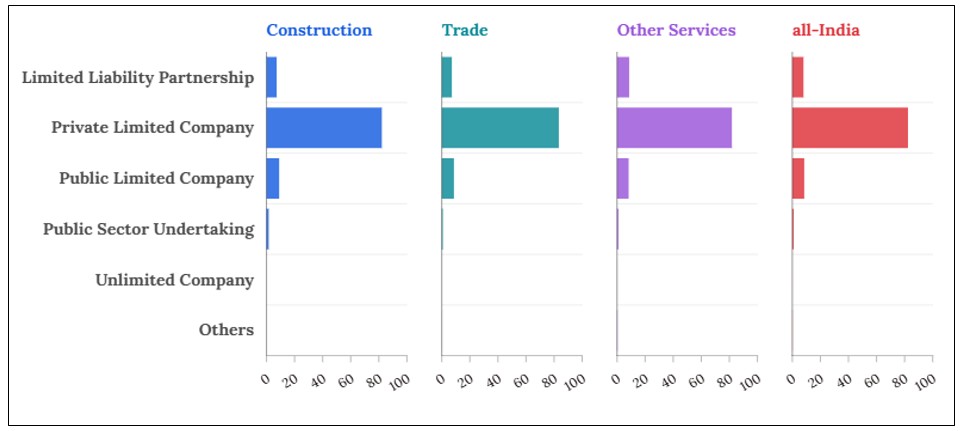Annual Survey of Services Sector Enterprises (ASSSE)

- 05 May 2025
In News:
The Ministry of Statistics and Programme Implementation (MoSPI) recently released findings from a pilot study on the Annual Survey of Services Sector Enterprises (ASSSE). This initiative aims to fill a crucial data gap regarding India’s incorporated service sector, which is not currently covered by regular surveys like the Annual Survey of Unincorporated Sector Enterprises (ASUSE).
Significance of the Services Sector
- Contribution to Economy: The services sector contributed ~55% of India's Gross Value Added (GVA) in FY 2024–25, up from 50.6% in FY14.
- Employment: It employs around 30% of India’s workforce, spanning industries like IT, finance, education, tourism, and healthcare.
- Trade: India’s services exports stood at USD 280.94 billion (April–Dec 2024). In ICT services, India is the 2nd-largest global exporter, accounting for 10.2% of global exports.
- FDI Magnet: The sector attracted USD 116.72 billion in FDI (April 2000–Dec 2024)—about 16% of total FDI inflows.
- Support to Digital India & Urbanization: The sector underpins the Digital India initiative and Smart Cities Mission by enabling digital payments, urban mobility, e-governance, and waste management.
About the ASSSE Pilot Study
Purpose & Objectives
- To test the suitability of the GSTN (Goods and Services Tax Network) database as a sampling frame.
- To develop robust survey instruments and methodology for a full-scale annual survey starting January 2026.
- To gather data on economic characteristics, employment, and financial indicators from incorporated enterprises under:
- Companies Act, 1956/2013
- Limited Liability Partnership (LLP) Act, 2008
Survey Coverage
- Conducted in two phases:
- Phase I (May–Aug 2024): Verified enterprise data for 10,005 units.
- Phase II (Nov 2024–Jan 2025): Collected detailed data from 5,020 enterprises under the Collection of Statistics Act, 2008.
- Data collected for FY 2022–23 using CAPI (Computer-Assisted Personal Interviewing).
Key Findings:
Enterprise Type Distribution
- Private Limited Companies: 82.4%
- Public Limited Companies and LLPs: ~8% each
Size-Class Analysis (FY 2022–23)
Output Class (?) % Share of Gross Value Added (GVA) % Share of Fixed Assets % Share of Employment
< 10 crore 1.19% 2.64% 9.28%
10–100 crore 9.45% 9.58% 20.03%
100–500 crore 19.90% 25.00% 33.73%
> 500 crore 69.47% 62.77% 36.96%
- Large enterprises (output > ?500 crore) dominate in assets, value addition, and compensation paid, but smaller units employ over 63% of the total workforce in the sample.
Additional Establishments
- 28.5% of enterprises reported having additional business locations within the state.
- Highest in the Trade sector (41.8%).
Insights and Challenges from the Pilot
- Suitability of GSTN as Sampling Frame: Confirmed.
- Challenges Faced:
- Data retrieval from enterprises with headquarters in other states.
- Centralized data (CIN-based) posed difficulty in disaggregating state-level data.
- Positive Outcomes:
- High response rate and cooperation.
- Survey instruments found largely clear and functional.
Challenges Faced by the Services Sector
- Skill Gaps:
- Only 51.25% of youth are employable (Economic Survey 2023–24).
- Merely 5% of workforce is formally skilled (WEF).
- Informality:
- About 78% of service jobs were informal in 2017–18.
- Gig workers lack social protection.
- Global Competition:
- Visa restrictions (e.g., H-1B in the US).
- Competing hubs: Philippines, Vietnam.
- Rising IT wage costs in India.
- Infrastructure Deficiencies:
- Inadequate AI/ML adoption.
- Digital divide persists in rural and marginalized MSMEs.
- Post-COVID Recovery:
- Inbound tourism yet to reach pre-pandemic levels (90% of 2019 arrivals in H1 2024).
Way Forward
- Upskilling Initiatives:
- Expand Skill India Digital and PMKVY 4.0.
- Promote Prime Minister Internship Scheme (PMIS) for bridging academia-industry gap.
- Boosting Global Competitiveness:
- Negotiate FTAs with EU, UK, Australia.
- Expand Global Capability Centres (GCCs).
- Digital Infrastructure & Security:
- Strengthen cybersecurity frameworks and promote secure cloud adoption.
- Improve digital literacy, especially in financial services.
- Decentralized Growth:As per NITI Aayog, promote services sector in Tier-2 and Tier-3 cities with better infrastructure and connectivity.
